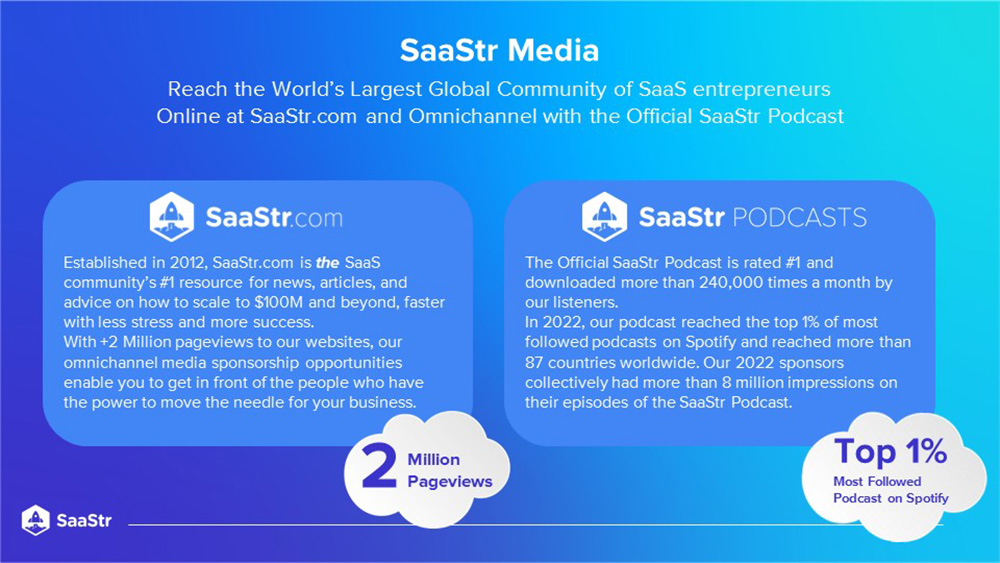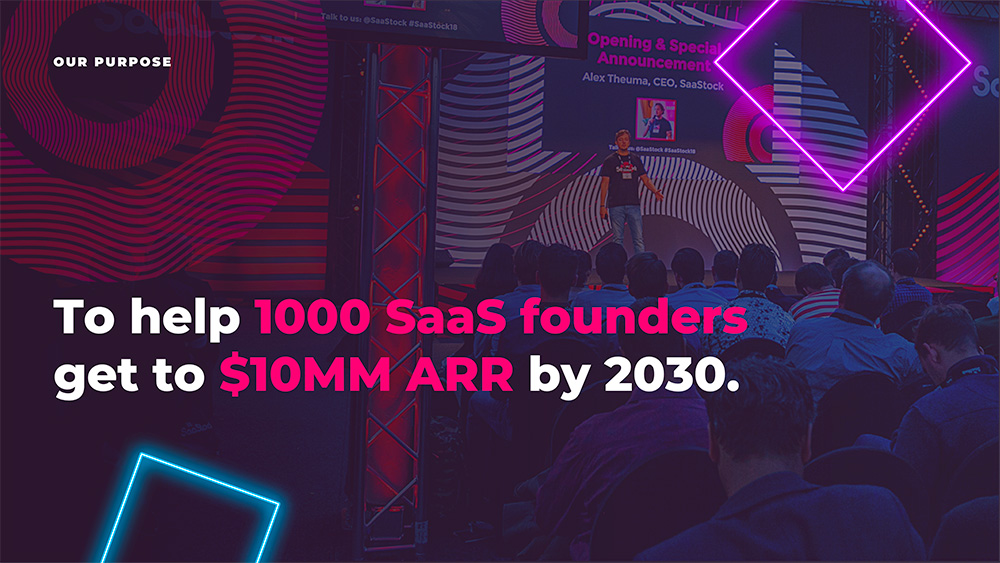The Rise of SaaS Content
A growing number of content channels are emerging to that focus exclusively on producing blogs, playbooks, videos, and podcasts for the SaaS industry. The GDP of the software industry is still relatively small compared to larger segments such as financial services, healthcare, and government. Gartner’s most recent IT spending forecasts estimated the worldwide SaaS market to be $232 billion in 2023 (less than a quarter of a trillion dollars).

- Market Capitalization – Technology and software companies dominate the stock market. Out of the top five companies with the highest market capitalization – four are software-centric.
- New Company Growth – There are over 5 million software businesses globally with more than 10 employees. There are tens of thousands more added each year fueled by the venture capital industry.
- Business Model Innovation – It’s hard to argue that any industry is more forward-thinking and focused on experimenting with go-to-market models, pricing strategies, and operating models.
Most of the SaaS content channels are owned by large, global players like SaaStr, SaaStock, and Future of SaaS. These organizations not only publish lots of content but also host in-person events and offer training programs for SaaS professionals. There are also a number of podcasts, email newsletter, and blog sites created by agencies and consultants that are worthwhile following on Spotify, Substack, and Medium.
SaaS content covers a diverse range of topics, but most of the blogs, podcasts, and videos focus on one of the following seven areas:
- Sales – Mastering bottom up and top down motions for PLG, designing compensation plans for maximum performance, and leveraging AI to improve win rates.
- Marketing – Scaling inbound lead generation, optimizing the outbound SDR motion, creating awesome content, and getting alignment with sales.
- Customer Success – Perfecting the on-boarding process, optimizing the customer experience, turning customers into advocates, and attacking churn.
- Product Management – Finding product-market fit, creating self-service experiences, shifting to a PLG model, adopting usage-based pricing.
- Human Resources – Building a hypergrowth culture, recruiting top talent, managing a remote workforce, and fostering diversity, equity, and inclusion.
- Finance and Accounting – Raising capital at different stages, alternatives to venture capital, and deep dives on SaaS metrics such as LTV/CAC, net retention, magic number.
Let’s review the big three SaaS content websites as well as discuss their unique strategies.
SaaStr
SaaStr is the undisputed heavyweight champion of the SaaS content world. The SaaStr website gets over 2M page views per month. The content engagement is massive as well. There are 220K podcast downloads per month ranking it in the top 1% of shows on Spotify. The email newsletter has a subscriber base of over 150K newsletter subscribers. Jason Lemkin, the founder, has over 1.25M social followers and ranks in the top 5 sales influencers on LinkedIn. The website is loaded with so much content that it’s growing increasingly challenging to navigate. In fact, it’s often easier to type a question into Google or Bing than navigate the site, because both search engines will point to an article from www.saastr.com on almost any SaaS-related search term.

The SaaStr team has cracked the code on writing the “must-read” content that every SaaS Founder and CEO is craving. The content strategy originally began with Jason Lemkin answering questions on Quora about 10 years ago. Today, they still take Q&A from the general public and that is one of the keys to success because the AMA approach enables the team to keep their finger on the pulse of the issues SaaS leaders are wrestling with. Another key success factor is the willingness to tackle, head-on, the burning questions that perplex CEOs. SaaStr offers advice on all the really hard questions like how to get initial traction and reach the first $1M in ARR, how to figure out your competitors’ revenue, and how long do you keep an underperforming sales rep.
- How do I hire the right people? SaaStr has over a dozen articles on how to hire the best sales, marketing, and customer success leaders and how avoid the ones that may look enticing but not deliver.
- How do I optimize go-to-market? SaaStr has over 100 interviews with Chief Revenue Officers from the world’s leading SaaS companies that share their dos and donts for beginners.
- How do I avoid first-timer mistakes? There are dozens of posts from real-world CEOs who made it big and share what they would have done differently if given an opportunity.
You don’t have to try hard to consume SaaStr’s content. It is almost impossible to avoid because it ranks so prominently on search engines for so many keywords. Nonetheless, visiting the website will help you understand the scope of what is available. The menu navigation links to helpful landing pages that round up the best articles on building a sales organization, learnings from public companies, and getting started with VC fundraising. You can have the latest content pushed to you by subscribing to email newsletters, which are offered in your choice of daily, weekly, and monthly formats. The podcast series can be accessed on Spotify, Apple, Soundcloud, or directly on the website. Those hungry for more content can join SaaStr Pro, a membership subscription that provides access to 50+ lessons on scaling your business, job listings, and VIP access to their various events.
Future of SaaS
The Future of SaaS is an online community for SaaS professionals in all functions to congregate. The community centers around the website and a Slack channel with over 500 active members. The community generates a wealth of content from founders, investors, and departmental leaders across sales, marketing, customer success, and product management. There is a SaaSfix email newsletter, a SaaScast podcast, and a series of expert video masterclasses named SaaStream. In addition, Future of SaaS publishes a series of annual research reports that gauge the pulse of their community on topics such as emerging technologies, future talent (rising stars), and tech stack adoption.

Although some of the content is free, much of it is behind a paywall as Future of SaaS has a membership business model. For ~$80 per month, members can get access to hundreds of templates and frameworks and thousands of hours of on-demand training courses on product marketing, sales enablement, and customer success.
SaaStock
SaaStock is a mission-driven organization aimed at helping B2B SaaS founders scale their organizations from $100K to $10M in annual revenues. SaaStock is best known for the series of conferences it hosts globally in both Europe and the US. The community also organizes local meetups in cities worldwide including Austin and Toronto in North America, Lisbon and London in Europe, and Seoul and Singapore in Asia.

Complementing the events is a massive content library most of which is aimed at CEOs and go-to-market leaders. The SaaStock website offers a library of ebooks including the signature Blueprint Series, a set of digital workbooks with targeted advice for CEOs, CFOs, CMOs, and CROs on making the journey from $100K to $100M. The SaaS Revolution is the name of the podcast series, which offers an extensive library of 300 recorded discussions of SaaS experts discussing the key challenges at each stage of growth from how startups can gain initial traction to how scale-ups can accelerate revenue growth. There’s also a video library called SaaStock.TV with 170+ hours of on-demand content from experienced SaaS leaders offering advice on topics ranging from branding and bootstrapping to culture and cash flow. An additional stream of content, blogs, and videos on Ventroduce – a sub-branded platform SaaStock created to facilitate fundraising discussions between venture capital firms and founders.
Much of the content is available to the general public, although often gated, but some of the higher-value assets are restricted behind a paywall. Founders can gain access to a more expansive content library as well as networking opportunities, monthly workshops, and roundtables through an annual membership subscription program.
SaaS Backwards
The SaaS Backwards podcast is hosted by Austin Lawrence, a growth agency that specializes in content marketing with some unique strategies such as inbound journalism and differentiated services like tailored coaching for first-time marketing executives.

The SaaS Backwards podcast features interviews with CEOs and CMOs from some of the SaaS industry’s fastest-growing firms. There’s usually at least one new podcast per week. The general theme of the discussion is lessons learned from real-world experiences – both successes and failures. However, each episode focuses on a specific topic. Recent examples include AI-powered SDR prospecting, the shift to product-led growth, and the concept of a Fractional Founder.
Silicon Slopes
Silicon Slopes is a community of entrepreneurs, investors, and practitioners from the booming tech startup scene in the state of Utah. The organization is not focused exclusively on technology-companies, but has a large population of SaaS and cloud providers from the greater Salt Lake area. Silicon Slopes is best known for its summit which features headline speakers like Tony Robbins, Tim Cook, Steve Ballmer, and Mark Zuckerberg.

Don’t let the Utah thing mislead you though, as the Silicon Slopes content is relevant to SaaS professionals regardless of location. The CEO, Clint Betts, publishes a weekly email newsletter with over 6000 subscribers highlighting upcoming events, job openings, and interesting news articles. Perhaps, most relevant for SaaS leaders is the podcast series, the Silicon Slopes Show, which features interviews with Utah tech CEOs, founders, and investors. Recent interviews have discussed cryptocurrency, DEI, talent development, and, leadership.









